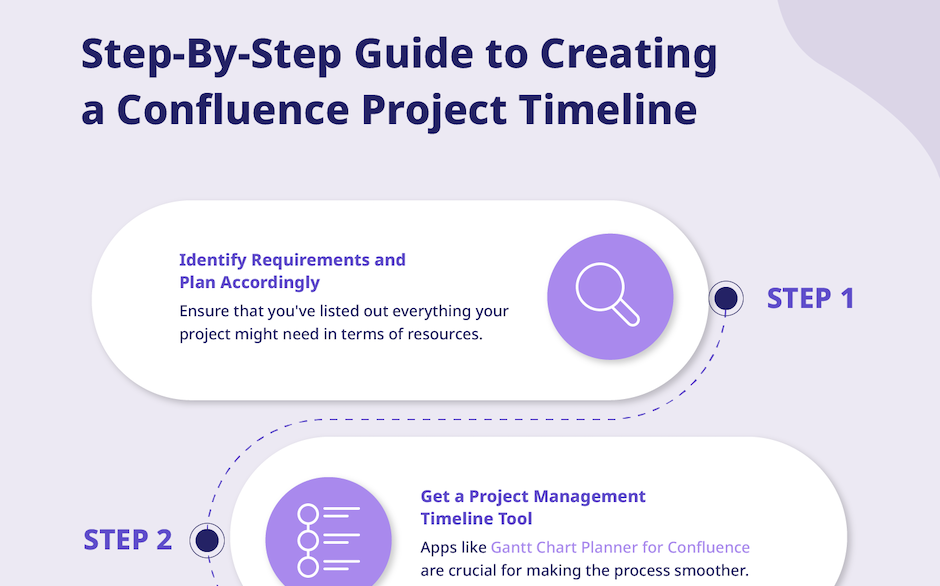A project timeline is one of the most important tools for the success of any project. It is a visual representation that depicts how a project is progressing, its milestones, and what dependencies it may have, to name a few elements. In other words, it’s the north star that guides both team members and stakeholders toward the completion of a project and ensures that it is done on time and within budget.
However, creating an effective project timeline in Confluence can be as challenging as it is rewarding, requiring careful short and long-term planning. So to help project managers (PMs) create a solid timeline plan, we’ll go over its best practices, walk you through making one from scratch, and even share a flowchart at the end!
Project Timeline Best Practices
Creating a project timeline can feel overwhelming because of the many factors you need to consider. However, PMs can make the process easier by keeping the following tips in mind:
Ensure You Share It and Collaborate with All Relevant Parties
The entire point of having a project timeline is so that everyone can readily refer to it to stay up-to-date on the project’s progress and needs. Therefore, not sharing it with all relevant parties will defeat its entire purpose and make it difficult for everyone to stay on the same page and work towards the same goals.
Additionally, PMs should consult their teams when creating a project timeline for several reasons. These include getting additional input, avoiding potential conflicts (e.g., overlapping tasks), and determining whether or not the timeline is realistic based on the team’s perspective. It is the team, after all, who’s responsible for the actual completion of tasks!
Properly Identify the Critical Path and Dependencies
In a nutshell, the critical path refers to a project’s tasks that need to be completed in a specific order to ensure the timely completion of the entire project. In a similar vein, dependencies depict the relationships between tasks and play an important role in the completion and scheduling of tasks.
With tasks and dependencies clearly identified and accounted for, you can ensure the timeline is as accurate as possible and that everyone involved can refer to it as a point of reference for the project.
Regularly Update Your Timeline
No matter how much time you spend on planning, no project is truly static. As it progresses, things change along with requirements and deadlines, and accepting this reality as PM goes a long way toward benefiting your project timeline.
Timelines must be regularly updated based on any relevant and recent changes. Whether it’s to do with adding new tasks, changing due dates, or assigning more resources to a particular dependency, a timeline that doesn’t reflect the present is practically useless — it’s history!
Consider Leveraging Gantt Charts
While there is a wealth of different timeline templates and examples available on the internet, Gantt charts should be high on any Confluence PM’s list due to their proven utility. Not only are they surprisingly easy to create on Confluence, but they are also incredibly advantageous.
From ensuring everyone is brought up to speed to tracking the progress of every task to even identifying the critical path along with dependencies, Gantt charts help guarantee that no team member is left behind.
Step-By-Step Guide to Creating a Marketing Project Timeline in Confluence
Now, to put all these practices into action, we’ll go through how to make a marketing project timeline in Confluence:
Step 1: Identify All Required Resources, Tasks, Marketing Goals, Etc.
The foundations for building a solid timeline require proper planning and foresight. Before even thinking about creating a marketing project timeline, PMs should sit down together with their teams and work to list out everything and anything the project might need.
This can include resources (e.g., time, materials) budgets, and setting clear, realistic goals and milestones. Above all, it is critical to involve everyone in the process, as having a more diverse and wider perspective will only serve to benefit the timeline.
Step 2: Get a Project Management Timeline Tool That Can Create Gantt Charts (i.e., GCP)
While PMs can technically make a marketing project timeline with native Confluence’s functionalities, doing so will quickly prove inefficient. It is time-consuming, and Confluence isn’t equipped with advanced key functions such as resource management.
This is why PMs should get external apps, namely: Gantt Chart Planner for Confluence which makes creating Gantt charts a smooth, hassle-free experience. With drag-and-drop simplicity and its intuitive UI and auto-schedule calculations, creating a visual project timeline in a Gantt chart in Confluence has never been easier.
Step 3: Create a Gantt Chart on Your Desired Confluence Page
Assuming you’ve decided to get Gantt Chart Planner for Confluence, the next step is to simply create a chart on your Confluence space based on your project’s needs.
Feel free to consult the app’s extensive documentation to learn more about the nitty-gritty behind its capabilities. You can also consult resources such as The Complete Guide to Using Gantt Charts in Agile Project Management to better understand Gantt charts in general!
Step 4: Edit and Input All Relevant Information into the Chart
Creating a Gantt chart on your Confluence space is only the beginning of your journey. You’ll now have to start adding all relevant information, such as creating tasks, assigning them to specific members, and setting deadlines.
Just be sure to input everything correctly and carefully as everybody will now use the chart!
Step 5: Update the Timeline Accordingly and Frequently
Just because you’ve finished creating your Gantt chart doesn’t mean your work as PM is over. PMs must continually update the timeline every now and then to reflect ongoing changes to provide as accurate a timeline as possible.
Whether it’s to do with updating the status of a task or changing deadlines, doing this is a must to prevent any confusion amongst teams.
Next Steps
Creating a good project timeline is a skill that even the most experienced PM will take time to learn. And thanks to add-ons such as Gantt Chart Planner for Confluence, the process doesn’t have to be as challenging as you might think. Additionally, with the help of our flowchart, just follow our steps and you’ll be on your way to project success!
Likewise, if you’re still on the fence, why not try our app today to see how it can benefit your organization?





